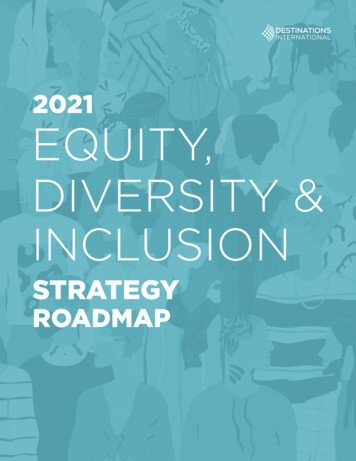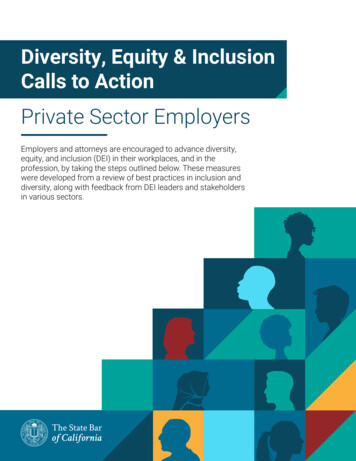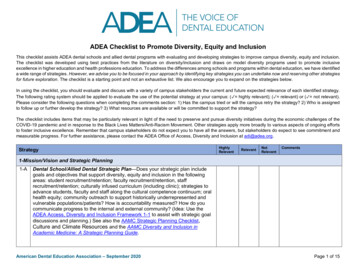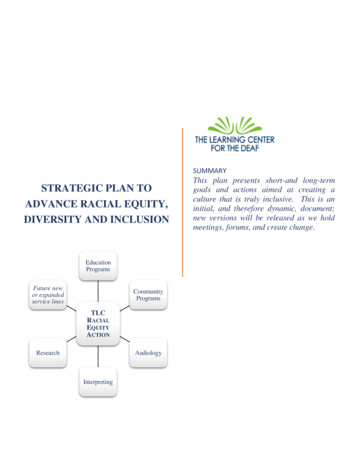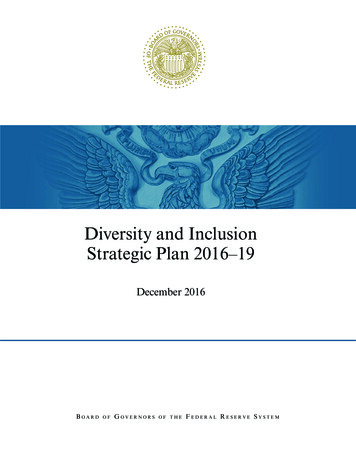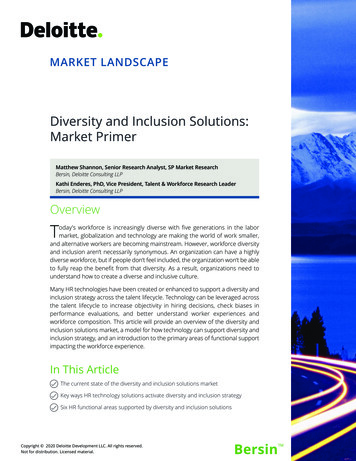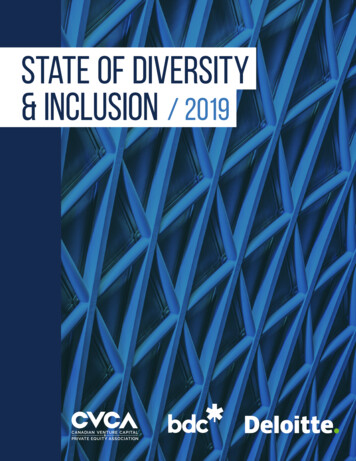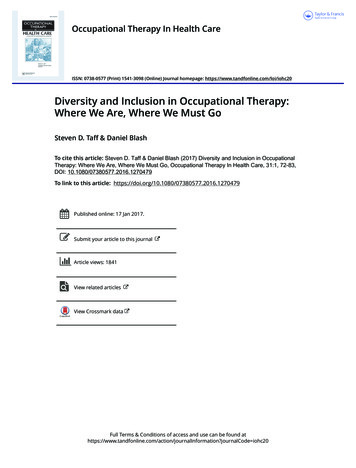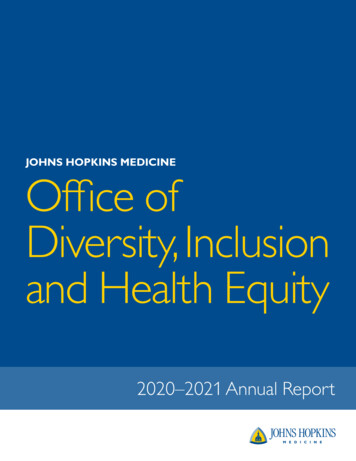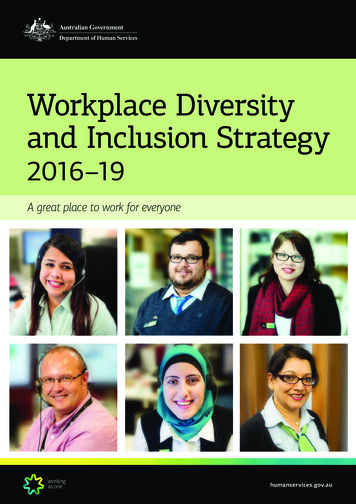
Transcription
Workplace Diversityand Inclusion Strategy2016–19A great place to work for everyonehumanservices.gov.au
What’s in our Workplace Diversity andInclusion Strategy 2016–19Message from our Secretary. 3What is diversity and inclusion?. 4Our diversity and inclusion journey. 5Listening to our people. 7Our diversity and inclusion vision. 8Inclusive leadership. 9Strategic alignment.10Our commitment to action.11Culturally and LinguisticallyDiverse (Multicultural) Employee Plan 2016–19.12Workplace Accessibility Plan 2016–19.14Mature Age Employee Plan 2016–19.16Gender Equality Plan 2016–19.18Lesbian, Gay, Bisexual, Transgenderand Intersex (LGBTI) Inclusion Plan 2016–19.20Definitions.222Department of Human Services
Message from our SecretaryI am pleased to present our Workplace Diversity and Inclusion Strategy andemployee plans developed in partnership with Enable Development, an awardwinning social enterprise led by passionate professionals with lived experiencesof disability. Our commitment to action, outlined in the strategy and plans,will continue to unlock the value a diverse and inclusive workforce brings toour services.The department is about connecting people to the services they need at differentstages of their lives. In fact, we touch the lives of almost every Australian withservices provided through a variety of channels including digital, telephone anda network of around 350 service centres across Australia. Each year we processaround 61 million Express Plus transactions, handle around 57 million calls andreceive around 26 million visits to our service centres.To achieve our overall vision of ‘excellence in the provision of government services toevery Australian’ we require a workforce that reflects the Australian communitythat we serve and a workplace which is inclusive and empowers everyone tocontribute their best. Diversity in our workforce is not just a ‘nice to have’, it’s abusiness imperative and it’s everyone’s responsibility.The department is a large part of the social fabric of the Australian community.Our size, geographical spread and service delivery focus provides both a socialresponsibility and opportunity to make a positive contribution to the diversity ofthe Australian Public Service (APS) workforce and to social inclusion outcomesfor the Australian community. This strategy and associated employee plansoutline our commitment to this responsibility. It also outlines our commitment toour people. We are committed to providing a positive and safe workplace whereinclusion is a priority.I am pleased that we will continue our journey with support through our valuablememberships with Diversity Council Australia, Australian Network on Disabilityand Pride in Diversity.I am proud of what we have already achieved. This strategy is a call to action forall leaders in the department to pave the way for diversity, access and inclusionand I encourage you all to contribute to making the department a great placeto work.Kathryn Campbell CSCSecretaryDepartment of Human ServicesWorkplace Diversity and Inclusion Strategy 2016–193
What is diversity and inclusion?DiversityDiversity is about our individual differences andacknowledging the unique blend of knowledge, skills andperspectives people bring to the workplace.Diversity can include characteristics such as culturalbackground and ethnicity, age, gender, gender identity,disability, sexual orientation, religious beliefs, languageand education. Diversity also includes characteristicssuch as professional skills, working style, location, andlife experiences.InclusionWhy diversity and inclusionmattersDiversity is central to innovation. It brings forth newand better ways of doing things, helps us to harness thebenefits of technology and improve the efficiency andquality of our services. Inclusion is the key to unlockingthis potential.When we value workplace diversity and inclusion wesee benefits such as higher employee engagement,improved performance, greater innovation, retentionof talent, improved employee wellbeing and lowerlevels of unlawful behaviour such as harassmentand discrimination.An inclusive culture is one where everyone feels valuedand respected and is able to fully contribute. It is aboutremoving barriers to make sure everyone can fullyparticipate in the workplace and have equal access toopportunities. Inclusion is about empowering people tocontribute their skills and perspectives for the benefit oforganisational performance and business outcomes.4Department of Human Services
Our diversity and inclusion journeyCelebrating our achievementsOur diversity and inclusion journey so far has beenguided by our previous strategy and plans which havehelped us to increase the diversity of our workforce andfoster an inclusive workplace.Guiding Our JourneyOur strategy and plans 2011–2015Our Workforce in 2016We have increased the diversity of our people23.9%CULTURAL ANDLINGUISTIC DIVERSITY4.9%EMPLOYEESWITH DISABILITY71.6%30.6%MATURE AGEEMPLOYEESWOMEN4.2%ABORIGINAL ANDTORRES STRAIT ISLANDEREMPLOYEESData as at 30 June 2016Workplace Diversity and Inclusion Strategy 2016–195
WORKING TOGETHER —BUILDING CAPABILITY—CHAMPIONING INCLUSION—INNOVATING—LEADING THE WAYNDACdedicated National Disability Access Coordinator (NDAC)providing workplace adjustment information and adviceKoomarri JobMatchReflection RoomsAWEIChampionsparticipating in the Australian Workplace Equality Index (AWEI) tobenchmark our LGBTI inclusion initiatives and help us identify where weare doing well and where we can improvesenior executive Disability Champions andIndigenous Champions providing leadershipand a voice to the needs of our employeespartnership with HP Australiaand Specialisterne providingtraineeships for people withAutism Spectrum Disorderproviding an extensive suite ofdiversity, Indigenous, multicultural,disability and LGBTI awarenessand inclusion learning solutionspeople with intellectual disabilityproviding administrative supportservices to the department since 1997provided for staff use forreflection, meditation or prayerDandelionProgramDiversityCapability MatrixEmployee NetworksRecruitAbilityproviding an avenue for employeesto connect, share information andideas and contribute to diversity andinclusion initiativesapplying RecruitAbility to allexternally advertised vacancies tosupport people with disability in theselection processANRGmaintaining a profile in the Australian National LGBTI Recruitment Guide topromote the department as an employer of choiceAccessibility Supportan innovative Accessibility Support Unit providingassistive technology support and solutions to staffwith disabilityCollaborationgetting involved in diversity and inclusion collaborationinitiatives such as the WorkAbility and Ageing Project,Inter-Agency Accessibility Support Unit Pilot and ICTAccessibility Community of PracticeWORKING TOGETHER —BUILDING CAPABILITY—CHAMPIONING INCLUSION—INNOVATING—LEADING THE WAY6Department of Human Services
Listening to our peopleWhat you had to sayOur people contributed to development of this strategy and employee plans.National Consultation 2015Employees had their say1000 online consultation survey focus groups across the countryWhat diversity and inclusion means to our KINGTOGETHERBREAKING DOWNBARRIERSYou said these are importantLeadership CommitmentWorkplace CultureSupervisor CapabilityWorkplace SupportFlexible Work PracticesWorkplace Diversity and Inclusion Strategy 2016–1998%98%92%92%81%7
Our diversity and inclusion visionOur goal is to reflect the diverse community weserve and create a great place to work for everyoneby embracing the individual skills, perspectives andexperiences our people bring to the workplace andharnessing these for high performance and improvedservice delivery.We want our people to feel included, valued andrespected and have access to equal opportunity,which supports full participation at work. We wantto retain the diverse talent in our workforce andsupport our people to maintain a long and productiveworking career.We aspire to having a positive impact on the Australiancommunity through our approach to diversity andinclusion and stewardship of our workforce whichrepresents almost a quarter of the APS.Our guiding principlesThe following guiding principles are key to achievingour diversity and inclusion vision. These criticalsuccess factors provide areas of focus for our diversityand inclusion actions as outlined in our supportingemployee plans.Recruit our workforce reflects the diversity of thecommunity we serveIncludeUltimately, we want to unlock the value that diversitybrings to our business. To achieve this we must create aculture shift that moves us away from traditional waysof thinking and towards practices which address theneeds of a contemporary workforce, maximise talentand embrace the use of technology and innovation. Wemust be bold in our approach and committed to action. our culture fosters access and inclusionEveryone in the department has a role to play insupporting a diverse, accessible and inclusive workplace.Managers must foster workplace flexibility and be opento different ways of working. Equally, employees mustdemonstrate the value flexible working arrangementsprovide the department and achievement of businessoutcomes. We all need to work together to create agreat place to work for everyone. we provide opportunity for growthDevelopLead we are bold and innovative, with leaders thatpave the way8Department of Human Services
Inclusive leadershipThe true benefits of a diverse workforce can only berealised when the workplace is inclusive and supportseveryone to achieve their best.Achieving an inclusive workplace that drivesperformance, innovation and productivity requiresinclusive leadership. Research by Diversity CouncilAustralia (DCA) refers to inclusive leadership asthe capabilities including the knowledge, skills andbehaviours that leaders possess which make theirorganisation inclusive.As stewards of our workforce, we challenge our leadersto apply these mindsets in their approach to leadershipand use them as a tool for improving individual, teamand organisational performance.As workplace diversity and inclusion is everyone’sresponsibility, these mindsets can be applied by all staffto benefit the workplace and foster an inclusive cultureacross the department.DCA’s Inclusive Leadership Model, shown below,identifies five mindsets, or ways of thinking, whichare necessary for a person to be an effectiveinclusive leader. These mindsets are Identity-Aware,Relational, Open and Curious, Flexible and Agile andGrowth-Focused.Source: Building Inclusion: An Evidence-Based Model of Inclusive Leadership, Diversity Council Australia, October 2015,www.dca.org.au, accessed 27 April 2016 (Image courtesy of Diversity Council Australia)Workplace Diversity and Inclusion Strategy 2016–199
Strategic alignmentA diverse workforce is critical to achieving our vision ofexcellence in the provision of government services to everyAustralian by providing us with the necessary knowledge,experience and capability to design and deliver serviceswhich best meet the needs of the Australian community.Fostering diversity in the workplace is required bythe Public Service Act 1999 as outlined in the APSEmployment Principles and supported by the APS Valuesand Code of Conduct. This strategy however takes usbeyond compliance, recognising diversity and inclusionas a key business enabler and a business imperative.Our Workplace Diversity and Inclusion Strategy 2016–19provides a roadmap to foster diversity and inclusion inour workforce, helping us make positive contributions tosocial inclusion and workforce participation.Corporate PlanExcellence in the provision of government services to every AustralianAPS ValuesGovernment outcomes,customer outcomesAPSEmploymentPrinciplesCapable andengaged peopleA strong collaborativeapproachServicetransformationWEOur CultureWorkplace Diversity and Inclusion StrategyA great place to work for everyoneRECRUITAPS Code ityINCLUDEMature AgeCulturally and LinguisticallyDiverse (Multicultural)Employee Plan 2016–19Workplace Accessibility Plan 2016–19Mature Age Employee Plan 2016–1910DEVELOPLGBTILEADGenderEqualityOur ServiceCommitmentsAboriginal andTorres StraitIslander peopleAboriginal and TorresStrait Islander EmployeesPlan 2016–17Gender Equality Plan 2016–19Lesbian, Gay, Bisexual, Transgenderand Intersex Inclusion Plan 2016–19Department of Human Services
Our commitment to actionEmployee plansWe have committed to a range of actions designed tobuild upon our inclusive workplace culture, retain ourdiverse workforce for the benefit of performance andproductivity and support our people to have long andproductive working careers.We acknowledge that staff may identify across anumber of diversity groups. This has been addressed byoutlining our commitments to action in the followingemployee plans: Culturally and Linguistically Diverse (Multicultural)Employee Plan 2016–19 Workplace Accessibility Plan 2016–19 Mature Age Employee Plan 2016–19 Gender Equality Plan 2016–19 Lesbian, Gay, Bisexual, Transgender and Intersex (LGBTI)Inclusion Plan 2016–19These actions will be implemented in the context of thedepartment’s business operations and achievement ofgovernment outcomes.Workplace Diversity and Inclusion Strategy 2016–19Aboriginal and Torres StraitIslander Employees PlanThis strategy is also underpinned by the department’sAboriginal and Torres Strait Islander EmployeesPlan 2016–17 and future iterations. This plan seeks toimprove the employment outcomes and experiences ofAboriginal and Torres Strait Islander people.Aligned to the department’s Reconciliation ActionPlan 2015–17 and Indigenous Servicing Strategy 2016–17the plan completes the department’s suite of Indigenousstrategic documents.Tracking our progressWe will monitor our progress against all our employeeplans and provide a progress report to our ExecutiveCommittee by December each year.We will regularly measure and monitor the diversityof our workforce, evaluate trends and identify areasfor improvement.11
Culturally and Linguistically Diverse (Multicultural)Employee Plan 2016–19Our aimWe aim to increase the representation of people fromculturally and linguistically diverse (CALD) backgroundsin our workforce and to value and embrace theirskills, perspectives and experiences for the benefit ofproviding culturally appropriate and improved servicesto the Australian community.We aim to celebrate the cultural and linguistic diversityof our people, provide a culturally safe and inclusiveworkplace and have a positive impact on social cohesion.This plan supports the government’s MulticulturalAccess and Equity Policy and the department’sMulticultural Servicing Strategy 2016–19 whichfocuses on ensuring our programs and services areresponsive to the needs of culturally and linguisticallydiverse customers.‘I’m an Australian born Lebanese woman and my first language was Arabic. Mybackground and my cultural upbringing has shaped who I am today. As a MulticulturalService Officer (MSO) my life experiences help me to provide better servicesto the community through understanding and empathy. I also try to promotecultural awareness with my colleagues by answering any questions they may have.Harmony Day is a great opportunity to celebrate our cultural diversity and to start aconversation to foster awareness and respect.’Marlene, Multicultural Service Officer, Zone Southern NSW‘I am from Chile in the Americas and immigrated to Australia in 1991 seeking abetter life for my family. I was a qualified Veterinarian and also had qualificationsin computing. In 1996 I joined the Commonwealth public service as an IT developer.Now at the EL2 level I have performed many roles, one of them being the DiversityAmbassador for the CIO Group in 2015. It was a great opportunity to promote culturaland other types of diversity. When we value diversity the workplace has more energyand engagement. People from different backgrounds and experiences can bring newperspectives and ways of doing our work, which challenges and helps us to improve.’Juan Carlos, Director, ICT Infrastructure12Department of Human Services
23.9%of our people are from culturally and linguistically diverse backgroundsOur commitment to actionRECRUIT—Our workforce reflects the diversity of the community we serveCALD 1We will explore a trial of an innovative recruitment approach that removes the name and genderof candidates from the initial assessment stage to prevent discrimination, stereotyping andhidden bias in the selection process.Dec 2017CALD 2We will review our people policies and practices and develop resources to implement betterpractice approaches to address unconscious bias in the workplace, including in selectionprocesses.Feb 2018INCLUDE—Our culture fosters access and inclusionCALD 3We will celebrate cultural days of significance such as Harmony Day and Refugee Week.AnnuallyCALD 4We will implement internal and external communication activities to promote cultural andlinguistic diversity and inclusion.ContinuingCALD 5We will facilitate a CALD employee network to provide staff opportunities to engage and tocontribute to CALD initiatives in the department.ContinuingCALD 6We will continue to provide culturally appropriate corporate wardrobe options to staff.ContinuingCALD 7We will continue the availability and awareness of reflection rooms for staff to use for personalreflection, meditation or prayer.ContinuingDEVELOP—We provide opportunity for growthCALD 8We will develop tools and resources to support multicultural capability, awarenessand understanding.July 2017CALD 9We will explore capability building options for effective communication.July 2018CALD 10We will ensure our Employee Assistance Program (EAP) providers are culturally competent.ContinuingCALD 11We will review and refresh our multicultural awareness e-learning and facilitated training andincrease uptake.ContinuingLEAD—We are bold and innovative, with leaders that pave the wayCALD 12We will become a member of the National Anti-Racism Partnership to contribute to theimplementation of the government’s National Anti-Racism Strategy and demonstrate ourcommitment to tolerance and anti-racism.Dec 2016CALD 13We will nominate and promote a Multicultural Champion at the senior executive level providingleadership to our cultural diversity initiatives and championing change to issues affecting stafffrom culturally and linguistically diverse backgrounds.Dec 2016CALD 14We will provide multicultural awareness training to our Senior Executive Service (SES).ContinuingCALD 15We will maintain our corporate membership with Diversity Council Australia (DCA).ContinuingWorkplace Diversity and Inclusion Strategy 2016–1913
Workplace Accessibility Plan 2016–19Our aimWe aim to increase the representation of people withdisability in our workforce including in senior leadershippositions and to improve their capability and careerdevelopment opportunities. We aim to be a disabilityconfident employer and to create an environment oftrust where staff with disability feel comfortable toshare their information with us.We are committed to eliminating or reducing barrierswhich prevent full participation at work and to providea universally accessible workplace which supports staffwith disability to fully contribute. We will build on oursuccessful programs and approaches to supporting theemployment and retention of people with disability, suchas the Dandelion Program, Scanning Operations Centreand Koomarri JobMatch Team.This plan supports the As One: APS Disability EmploymentStrategy 2016–19 and will be implemented in alignmentwith the department’s Aboriginal and Torres StraitIslander Employees Plan 2016–17 to support theemployment, development and career progression ofIndigenous people with disability.Our commitment to actionRECRUIT—Our workforce reflects the diversity of the community we serveWAP 1We will pilot a targeted recruitment pathway program, using measures available in the AustralianPublic Service Commissioner’s Directions, to increase the employment of people with disability.Dec 2017WAP 2We will review our people policies and practices and develop resources to implement better practiceapproaches to address unconscious bias in the workplace, including in selection processes.Feb 2018WAP 3We will apply RecruitAbility to all externally advertised vacancies including SES roles.ContinuingWAP 4We will provide workplace adjustment training to recruitment teams and selection panels.ContinuingWAP 5We will ensure recruitment systems and processes are accessible and inclusive for peoplewith disability.ContinuingWAP 6We will promote our work experience and entry level pathway programs to provide employmentopportunities for people with disability, including Indigenous people with disability.ContinuingWAP 7We will partner with external organisations and providers to provide employment opportunities forpeople with disability.ContinuingINCLUDE—Our culture fosters access and inclusion14WAP 8We will implement a Workplace Adjustment policy and guidelines which makes it easier to request,access and implement workplace adjustments and assists employees with disability to perform attheir best.July 2017WAP 9We will celebrate events of significance such as International Day of People with Disability, R U OK?Day and World Mental Health Day.AnnuallyWAP 10We will implement internal and external communication activities to raise disability awarenessincluding awareness of invisible disabilities and which promote workplace accessibility and inclusion.ContinuingWAP 11We will maintain our workplace accessibility support programs including a National DisabilityAccess Coordinator and the Accessibility Support Unit, to ensure employees with disability and theirsupervisors have access to information and support for workplace adjustment.ContinuingWAP 12We will facilitate a disability employee network to harness the experiences, knowledge and passionof employees to support information, engagement and innovation in fostering an accessible andinclusive workplace culture.ContinuingWAP 13We will implement measures that foster a culture of trust and inclusion, where employees feelcomfortable to share their disability information and supervisors are responsive to accommodatingaccessibility needs.ContinuingDepartment of Human Services
4.9%of our people have self-identified as a person with disability‘I was diagnosed with a number of disorders in 2009 and have had to be hospitalisedfor treatment. I have learned to embrace the challenges that come with my condition.Raising awareness of mental health is now a passion of mine and I deliver a number of thedepartment’s mental health awareness programs. If you have a condition that may affect youat work the key message is to talk to your manager about it. That way they can know how tosupport you. I also encourage staff to identify in the Equity and Diversity page in ESSentials.This will ensure the department can tailor training and initiatives to support staff.’Adrian, Learning Specialist, People Capability‘My name is Sana and I work differently. I am legally blind with a degenerative eyecondition that causes colour blindness and extreme sensitivity to light. I use a range ofadjustments at work such as screen readers and magnifiers and I have an office with nolight. The department’s Accessibility Support Unit, which set-up my assistive technologyand provides me with ongoing support, is fantastic. However, the most important supportcomes from my manager and senior leaders. They break down barriers by acknowledgingthat I need to work differently and support me to get access to the tools I need.’Sana, Assistant Director, Aged CareDEVELOP—We provide opportunity for growthWAP 14We will implement a Psychological Health Strategy and action plan that promotes mental health andwellbeing.Dec 2016WAP 15We will develop an accessibility self-paced training package to increase accessibility awareness andcapability to meet the needs of employees with disability, including users of assistive technology.March 2018WAP 16We will explore implementation of a targeted mentoring program for employees with disability whodemonstrate consistent high performance and potential to advance to the Executive Level or higher.Feb 2019WAP 17We will increase uptake of the Disability Capability Program, in particular by managers and teamleaders, to improve disability awareness and confidence across the department.ContinuingWAP 18We will increase awareness of mental health conditions and the uptake of mental health learningsolutions, particularly completion by managers.ContinuingWAP 19We will continue to enhance accessibility and compatibility of e-learning products and aim to adoptbest practice.ContinuingLEAD—We are bold and innovative, with leaders that pave the wayWAP 20We will establish a departmental disability employment target.Jan 2017WAP 21We will build on our existing workplace accessibility programs to maximise digital technologyimprovements and provide innovative accessibility solutions for employees with disability.ContinuingWAP 22We will review our procurement policies and practices to ensure accessibility is considered in service,system or property related procurement activities.Dec 2018WAP 23We will maintain our corporate Gold membership with Australian Network on Disability (AND).AnnuallyWAP 24We will maintain Disability Champions at the senior executive level providing leadership to ourdisability employment initiatives and championing change to issues affecting staff with disability.ContinuingWAP 25We will continue to implement a mandatory Changing Mindsets: Direct Experiences Program toencourage SES leaders to think differently about the recruitment, career progression and overallwork experience of people with disability.ContinuingWAP 26We will continue to explore opportunities to provide accessibility support shared services to otherAPS agencies.ContinuingWorkplace Diversity and Inclusion Strategy 2016–1915
Mature Age Employee Plan 2016–19Our aimOur aim is to increase the representation of matureage people in our workforce and to harness theexpertise and experience this talent source brings to ourperformance and productivity.We aim to retain our mature age employees andrecognise the wealth of corporate knowledge theybring to the workplace and the important rolethey play in passing on this knowledge to supportimproved performance and succession planningin the department.We strive to remove barriers to workforce participationfor mature age people and to support them to engage ina longer, productive working life.‘I am an Aboriginal woman born and raised on Kalkadoon land from Cloncurry in FarNorth-West Queensland. I’ve been in Canberra for over 30 years however my career hasspanned a number of jobs including enlisting in the Royal Australian Air Force, workingin a law firm, and I’ve just completed 20 years in the Australian Public Service. I may beof mature age but I still have career plans ahead. I plan to transition to a new careerdown the track but for now I love what I do. I bring decades of work and life experiencesto my job. It’s great to come to work, help others and know that I make a difference.’Nicki, Assistant Director, Indigenous, Regional and Intensive Services‘In 1972 I started my career in Mothercraft Nursing however later in life I went backto formal studies and completed a Diploma in Welfare and Bachelor of Social Science.I joined CRS Australia in 2010 and then transitioned to the Authorised Review Officer rolewhen CRS ceased operating. Dealing with change and learning new things requires theright mindset. You need to believe in yourself and the workplace needs to believe in youtoo. The type of reviews I do now are a good fit with my previous work experience andwhile I’m still learning I’m also able to share my knowledge to help my colleagues.’Bambi, Authorised Review Officer, Customer Payment Services16Department of Human Services
30.6%of our people are aged 50 or overOur commitment to actionRECRUIT—Our workforce reflects the diversity of the community we serveMA 1We will develop procedures and guidance which support employees seeking to change theiremployment status from ongoing to non-ongoing as a transition to retirement arrangement.Aug 2017MA 2We will trial a targeted ‘Career Restart’ recruitment campaign which targets people who are matureage seeking to re-enter the workforce or to extend their working life via a new career path.Dec 2017MA 3We will review our people policies and practices and develop resources to implement better practiceapproaches to address unconscious bias in the workplace, including in selection processes.Feb 2018MA 4We will actively encourage mature age people to apply for the department’s vacancies, promotethe department as a flexible workplace and ensure our recruitment policies and practices are agefriendly.ContinuingINCLUDE—Our culture fosters access and inclusionMA 5We will implement internal and external communication activities which are age-positive
outcomes. We all need to work together to create a great place to work for everyone. Our guiding principles The following guiding principles are key to achieving our diversity and inclusion vision. These critical success factors provide areas of focus for our diversity and inclusion actions as outlined in our supporting employee plans. Recruit .


